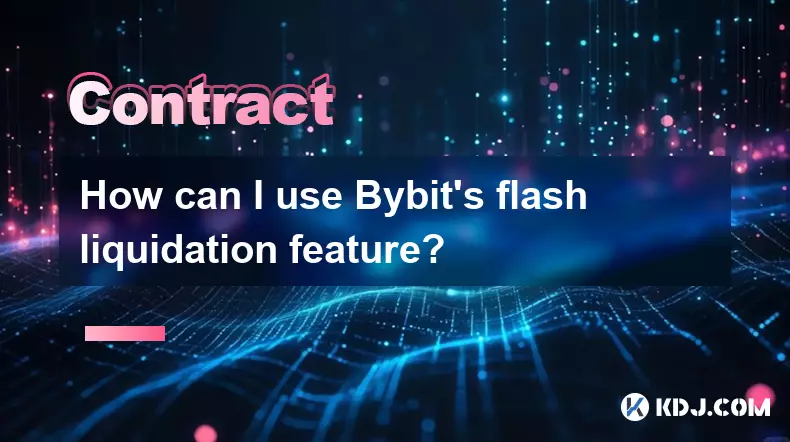-
 bitcoin
bitcoin $122288.232522 USD
0.16% -
 ethereum
ethereum $4480.662914 USD
-0.22% -
 xrp
xrp $2.962747 USD
-2.32% -
 tether
tether $1.000120 USD
-0.05% -
 bnb
bnb $1145.654223 USD
-2.07% -
 solana
solana $227.105217 USD
-1.67% -
 usd-coin
usd-coin $0.999548 USD
-0.02% -
 dogecoin
dogecoin $0.250875 USD
-2.04% -
 tron
tron $0.340654 USD
-0.49% -
 cardano
cardano $0.837968 USD
-2.52% -
 hyperliquid
hyperliquid $48.960449 USD
0.06% -
 chainlink
chainlink $22.049280 USD
-1.33% -
 ethena-usde
ethena-usde $1.000404 USD
0.02% -
 sui
sui $3.586212 USD
0.20% -
 avalanche
avalanche $29.894916 USD
-4.18%
How can I use Bybit's flash liquidation feature?
Bybit's flash liquidation instantly closes leveraged positions when margin falls below maintenance levels, preventing negative equity and reducing market impact.
Sep 19, 2025 at 01:00 am

Understanding Bybit's Flash Liquidation Mechanism
1. Bybit's flash liquidation feature is designed to manage positions that fall below the required maintenance margin. When a trader’s margin balance drops to the liquidation threshold, the system automatically begins the liquidation process. This prevents further losses and protects both the user and the exchange from negative equity.
2. The flash liquidation occurs almost instantly once the mark price reaches the liquidation price. It differs from traditional liquidation in speed and execution method. Instead of waiting for an auction or matching engine to clear the position, the system uses internal mechanisms to close the trade rapidly, minimizing slippage and market impact.
3. Traders must understand that this mechanism applies only to isolated margin modes in perpetual and futures contracts. Cross margin positions are handled differently and do not qualify for flash liquidation treatment. Users should verify their margin mode before opening high-leverage trades.
4. During periods of extreme volatility, such as major news events or sudden macroeconomic shifts, flash liquidations may occur more frequently. These conditions can cause rapid price movements that trigger liquidation levels even with stop-loss orders in place.
5. Bybit provides real-time risk indicators on its trading interface, including estimated liquidation prices and current margin ratios. Monitoring these values closely allows traders to adjust their positions proactively and avoid unexpected flash liquidations.
Strategies to Avoid Unintended Flash Liquidations
1. Setting appropriate leverage is crucial when trading on Bybit. High leverage increases profit potential but also raises the likelihood of being flash liquidated. Conservative traders often use lower leverage settings to maintain larger buffer zones between entry and liquidation prices.
2. Utilizing take-profit and stop-loss orders helps manage exposure without relying solely on manual monitoring. These tools allow automatic exits at predefined levels, reducing emotional decision-making during volatile market swings.
3. Regularly checking funding rates and open interest trends gives insight into market sentiment and potential squeeze scenarios. Sudden spikes in long or short concentration can precede sharp reversals that trigger mass liquidations across the platform.
4. Diversifying position sizes across multiple entries instead of deploying full capital at one level spreads risk. This strategy, known as scaling in, reduces the impact of any single price movement on overall portfolio health.
Maintaining sufficient available balance in your wallet ensures you have room to absorb temporary drawdowns without hitting liquidation thresholds.Impact of Flash Liquidation on Market Dynamics
1. Flash liquidations contribute to cascading price effects when large numbers of positions are triggered simultaneously. A sharp drop can initiate a wave of automatic sell-offs, amplifying downward momentum and creating volatility spikes.
2. Market makers and arbitrageurs often monitor liquidation clusters to anticipate short-term directional moves. Areas with high concentrations of long or short liquidation prices become key psychological and technical zones.
3. Bybit displays a liquidation heatmap on its analytics page, showing where major liquidation levels are clustered. This data helps traders identify danger zones and structure entries and exits accordingly.
Exchanges benefit from reduced counterparty risk due to fast liquidation processing, ensuring the insurance fund remains stable even during turbulent conditions.4. Frequent flash liquidations in a specific contract may indicate overleveraged positioning by retail traders. Institutional participants often interpret these patterns as contrarian signals, entering opposite positions when liquidation pressure appears exhausted.
Frequently Asked Questions
What happens to my funds after a flash liquidation?After a flash liquidation, the system closes your position at the prevailing mark price. Any remaining equity above the used margin is returned to your account. If the liquidation results in a deficit, Bybit covers it using the insurance fund, so you are not liable for additional payments.
Can I disable flash liquidation on my Bybit account?No, flash liquidation cannot be disabled. It is an automated risk management function built into the platform’s infrastructure. All users trading leveraged products are subject to this mechanism regardless of preferences.
Does flash liquidation affect spot trading accounts?Flash liquidation only applies to derivative products such as futures and perpetual contracts. Spot trading does not involve borrowed funds or margin requirements, so this feature has no relevance in non-leveraged transactions.
How quickly does a flash liquidation execute?Execution typically occurs within milliseconds once the mark price hits the predetermined liquidation level. The exact timing depends on network latency and server load, but the process is significantly faster than manual or auction-based liquidations.
Disclaimer:info@kdj.com
The information provided is not trading advice. kdj.com does not assume any responsibility for any investments made based on the information provided in this article. Cryptocurrencies are highly volatile and it is highly recommended that you invest with caution after thorough research!
If you believe that the content used on this website infringes your copyright, please contact us immediately (info@kdj.com) and we will delete it promptly.
- BlockDAG, DOGE, HYPE Sponsorship: Crypto Trends Shaping 2025
- 2025-10-01 00:25:13
- Deutsche Börse and Circle: A StableCoin Adoption Powerhouse in Europe
- 2025-10-01 00:25:13
- BlockDAG's Presale Buzz: Is It the Crypto to Watch in October 2025?
- 2025-10-01 00:30:13
- Bitcoin, Crypto, and IQ: When Genius Meets Digital Gold?
- 2025-10-01 00:30:13
- Stablecoins, American Innovation, and Wallet Tokens: The Next Frontier
- 2025-10-01 00:35:12
- NBU, Coins, and Crypto in Ukraine: A New Yorker's Take
- 2025-10-01 00:45:14
Related knowledge

What is the difference between futures and perpetual contracts for Bitcoin?
Oct 02,2025 at 11:54pm
Understanding Bitcoin Futures Contracts1. Bitcoin futures are derivative instruments that allow traders to speculate on the future price of Bitcoin at...

What is the best time to trade PEPE contracts?
Oct 03,2025 at 11:54am
Understanding PEPE Contract Volatility1. PEPE contracts exhibit extreme price fluctuations due to their meme-based nature and low market cap. Trading ...

What are the common mistakes to avoid with Bitcoincoin contracts?
Oct 03,2025 at 08:54am
Emerging Trends in the Cryptocurrency Market1. Decentralized finance (DeFi) platforms continue to expand their influence across the blockchain ecosyst...

What is the maintenance margin for Bitcoin contracts?
Oct 02,2025 at 01:36am
Decentralized Exchanges Gain Momentum in 20241. Decentralized exchanges (DEXs) have seen a significant rise in trading volume, surpassing centralized ...

How to use technical analysis for trading XRP contracts?
Oct 03,2025 at 01:18pm
Understanding Price Patterns in XRP Futures1. Identifying chart patterns such as triangles, head and shoulders, and double tops or bottoms can provide...

What does "longing" PEPE contracts mean?
Oct 03,2025 at 11:54pm
Understanding Decentralized Exchanges in the Crypto Ecosystem1. Decentralized exchanges (DEXs) operate without a central authority, allowing users to ...

What is the difference between futures and perpetual contracts for Bitcoin?
Oct 02,2025 at 11:54pm
Understanding Bitcoin Futures Contracts1. Bitcoin futures are derivative instruments that allow traders to speculate on the future price of Bitcoin at...

What is the best time to trade PEPE contracts?
Oct 03,2025 at 11:54am
Understanding PEPE Contract Volatility1. PEPE contracts exhibit extreme price fluctuations due to their meme-based nature and low market cap. Trading ...

What are the common mistakes to avoid with Bitcoincoin contracts?
Oct 03,2025 at 08:54am
Emerging Trends in the Cryptocurrency Market1. Decentralized finance (DeFi) platforms continue to expand their influence across the blockchain ecosyst...

What is the maintenance margin for Bitcoin contracts?
Oct 02,2025 at 01:36am
Decentralized Exchanges Gain Momentum in 20241. Decentralized exchanges (DEXs) have seen a significant rise in trading volume, surpassing centralized ...

How to use technical analysis for trading XRP contracts?
Oct 03,2025 at 01:18pm
Understanding Price Patterns in XRP Futures1. Identifying chart patterns such as triangles, head and shoulders, and double tops or bottoms can provide...

What does "longing" PEPE contracts mean?
Oct 03,2025 at 11:54pm
Understanding Decentralized Exchanges in the Crypto Ecosystem1. Decentralized exchanges (DEXs) operate without a central authority, allowing users to ...
See all articles










































































